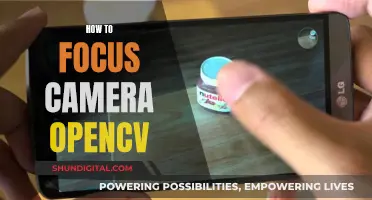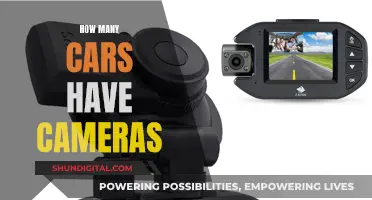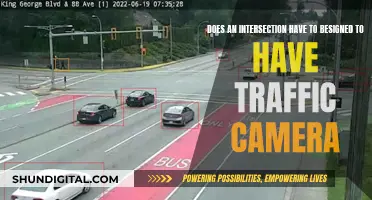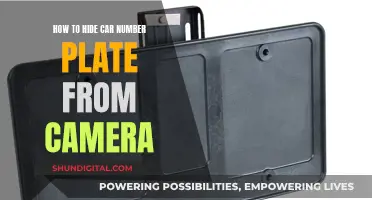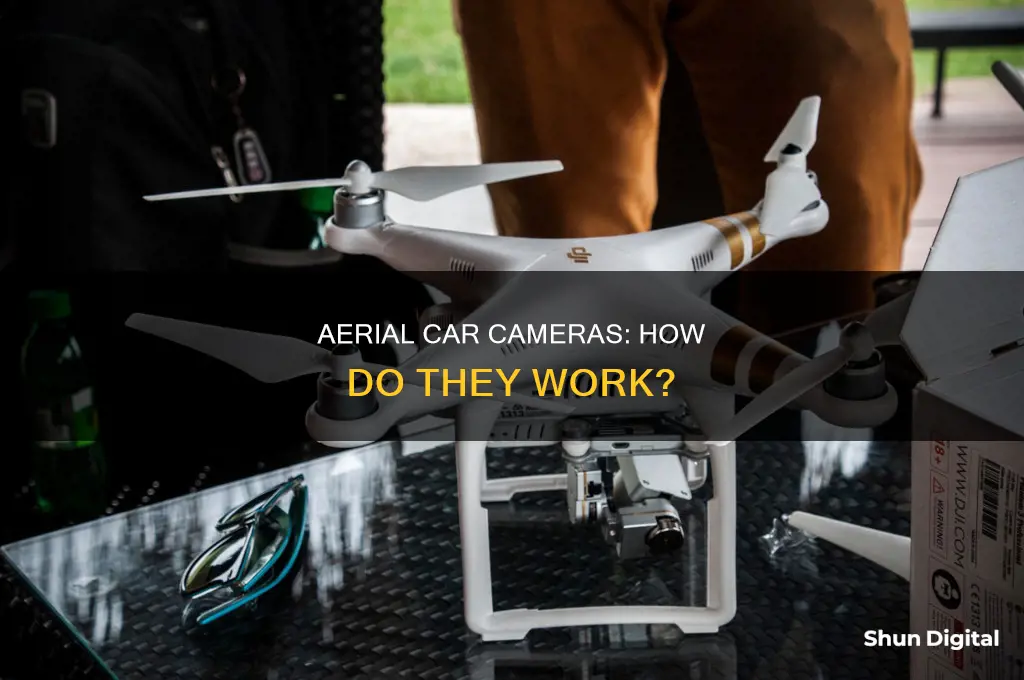
The bird's eye view in cars is not a camera shot but a composite of shots from all the cameras on the car. These cameras are usually wide-angle lenses integrated into the body panel of the vehicle, capturing front, rear, and side exterior angles. The images are then stitched together by an image-processing system, creating a lifelike yet synthetic top-down view of the car and its surroundings. This technology, also known as a 360-degree camera or surround-view camera system, is particularly useful for parking and manoeuvring in tight spaces, as well as reducing blind spots.
| Characteristics | Values |
|---|---|
| Number of Cameras | 4-6 |
| Camera Placement | Front grille, under rear-view mirrors, tail, side-view |
| Camera Type | Wide-angle |
| Image Processing | Images are stitched together by an image processing system |
| Display | Split-screen display on infotainment system |
What You'll Learn
- Aerial cameras are a composite of camera angles from several locations around the vehicle
- The images are stitched together by an image-processing system
- The cameras are placed on the front grille, under rear-view mirrors, and on the tail
- Proximity sensors aid in evaluating the distance of nearby objects
- Feedback mechanisms such as audio alerts notify the driver of nearby objects

Aerial cameras are a composite of camera angles from several locations around the vehicle
Cars have what is known as a "bird's eye view" or "surround-view" camera system, which offers a top-down view of the car and its surroundings. This system is made possible by several cameras placed in strategic spots around the vehicle. These cameras are typically positioned in the front grille, exterior rear-view mirror areas, and at the rear of the vehicle, functioning as a back-up camera. The images from these cameras are then stitched together by an image-processing program, creating a composite image that appears as if it were captured by a drone or blimp.
The camera system uses multiple cameras to capture a 360-degree view of the car's surroundings. These cameras have wide-angle lenses to capture as much information as possible. The software then merges these images to create a simulated aerial view, as if the car were being filmed from about 10 meters directly above. This composite image is then displayed on the car's infotainment screen, often with a picture of the car in the centre to provide a reference point.
The bird's-eye view camera system is an invaluable feature for drivers, especially when backing into or out of confined spaces. It provides a split-view image, allowing drivers to see not only what is behind the car but also the surrounding area in every direction. This makes parallel parking or pulling into a narrow parking space much easier and safer. The system also includes proximity alerts, making it easier to correct your course and avoid obstacles.
In addition to parking assistance, the camera system can be used for other purposes such as checking the passenger side of the vehicle, seeing what is in front of the car below the field of vision, and aiding in off-road situations. The system also superimposes guidelines onto the image, showing the vehicle's current orientation and expected direction of travel.
Many automakers now offer vehicles with 360-degree camera systems, although they are typically found in higher trim levels or luxury models due to the high cost of the technology. Some examples include the Lincoln Corsair, Genesis G70, and various models from Nissan, Toyota, and Mitsubishi.
Power-Saving Mode: Friend or Foe to Your Camera?
You may want to see also

The images are stitched together by an image-processing system
The images from the cameras are stitched together by an image-processing system, which uses software to create a single, coherent, seamless, lifelike yet synthetic, top-down composite view of the car and its surroundings. This is similar to how a panorama photo is created, except the images are uniquely angled to surround a centred vehicle.
The image-processing system uses algorithms to create composite images. The geometric alignment process includes lens distortion correction and the transformation of perspective. The photometric alignment process matches the brightness and colour of individual camera views so that the final image appears to have been captured by a single camera. The composite view synthesis process is where the actual stitching of images takes place.
Image registration is the process of detecting key points on an image and assigning them to a common ground plane. Custom pattern registration is the image registration process commonly used in 360-degree vision systems.
The next step is warping, where the undistorted image is deformed to match some defined key points. Techniques such as homography, polynomial deformation, or moving least squares are performed for image deformation.
The final step is blending, where the individual images are merged to obtain the stitched image. Multiband blending (which offers the best resolution), feathering, and 50% blending are commonly used algorithms for this step.
Focusing Your Luma Camera: The Ultimate Guide
You may want to see also

The cameras are placed on the front grille, under rear-view mirrors, and on the tail
The placement of cameras is crucial in surround-view camera systems, as they need to be able to view the vehicle perimeters clearly without disrupting the aesthetics of the car or any other functionality. The cameras are usually placed on the front grille, under the rear-view mirrors, and on the tail, with the exact spots carefully chosen through simulations of CAD models of the vehicle to analyse the field of view and blind zones from different angles.
The front grille camera is typically placed in the centre, offering a direct view of the car's front. This central position ensures that the camera has an unobstructed view, capturing images that will later be synthesised with those from other cameras to create a cohesive bird's-eye view.
Cameras placed under the rear-view mirrors, usually on either side of the car, are wide-angle lenses that capture the sides of the vehicle. These cameras are positioned in the exterior rear-view mirror areas, providing a clear view of the adjacent lanes and nearby obstacles.
The camera on the tail is often placed near the rear licence plate, offering a broad view of what's behind the vehicle. This camera also functions as the back-up camera, aiding the driver when reversing or parking.
These cameras, along with others in the system, work together to provide a surround or bird's-eye view. The images they capture are stitched together using image processing software, creating a seamless, cohesive view of the car and its surroundings in real time. This technology transforms parking and manoeuvring in tight spaces into a much more manageable task.
Mastering Camera Rotation in Modding: A Step-by-Step Guide
You may want to see also

Proximity sensors aid in evaluating the distance of nearby objects
Proximity sensors are an integral part of modern vehicles, aiding in parking, safety, and navigation. These sensors can detect the presence and distance of nearby objects without physical contact, making them ideal for various automotive applications.
One of the most common uses of proximity sensors in cars is parking assistance. By emitting electromagnetic fields or beams of electromagnetic radiation, such as infrared, proximity sensors can accurately gauge the distance to nearby objects, helping drivers maneuver into tight parking spots. This technology, often marketed as "Bird's Eye View" or "Surround View," utilizes multiple cameras and sensors to provide a top-down view of the vehicle and its surroundings. This system not only aids in parallel parking but also enhances safety by alerting drivers to nearby obstacles.
Proximity sensors can also be used for obstacle detection and avoidance while driving. By continuously monitoring the distance to nearby objects, the sensors enable features like collision avoidance systems, enhancing driver awareness and safety. Additionally, proximity sensors play a crucial role in autonomous vehicles, enabling them to navigate complex environments, avoid obstacles, and make precise maneuvers.
The versatility of proximity sensors extends beyond parking and collision avoidance. They can also assist in various driving scenarios, such as pulling out of a blind alley onto a busy street or off-road driving. With the ability to detect objects in close proximity, these sensors improve overall driving safety and situational awareness.
In conclusion, proximity sensors play a vital role in evaluating the distance of nearby objects, enhancing the safety and functionality of modern vehicles. By providing valuable data for computer systems to process, proximity sensors contribute to a more seamless driving experience, making advanced driver-assistance features and autonomous driving a reality.
Computer Cameras: Are They Spying on You?
You may want to see also

Feedback mechanisms such as audio alerts notify the driver of nearby objects
Surround-view camera systems in cars are made possible by several cameras placed strategically around the vehicle. These cameras are typically positioned in the front grille, exterior rear-view mirror areas, and at the rear of the vehicle, functioning as a back-up camera. Additionally, some cars have side-view cameras positioned ahead of the front wheels, providing a view of what's on the other side of obstacles.
The video signals from these cameras are fed into an image-processing program, which knits together the individual inputs to create a top-down, bird's-eye view of the car and its surroundings. This technology is especially useful for parking, providing a split-screen view of the rear and surround-view images.
To enhance safety, these systems often incorporate audible alerts and/or haptic warnings that notify the driver when they are too close to an obstruction. These feedback mechanisms are crucial, as they provide an extra layer of awareness beyond the visual display, ensuring that drivers are fully informed of their surroundings.
For instance, ultrasonic sensors use sonar to detect echo times from sound waves bouncing off nearby objects. As the vehicle gets closer to an object, the sensors identify the proximity and trigger alerts to the driver. Similarly, electromagnetic sensors create an electromagnetic field around the bumper and provide notifications when objects enter this field.
In recent years, upgrades have been introduced, with some vehicles now including a digital display that shows the specific part of the car that is closest to an object. These advancements in feedback mechanisms, such as audio alerts, play a vital role in improving driver awareness and enhancing overall safety.
Spotting Fake Surveillance Cameras: What to Look For
You may want to see also
Frequently asked questions
Cars don't have aerial cameras. The "bird's eye view" is a composite image made from multiple cameras positioned around the car.
The bird's eye view is a computer-generated image. The car combines data from multiple cameras positioned around the car and stitches the images together to create a top-down view.
The bird's eye view camera system offers several benefits. It makes parking easier and safer, reduces blind spots, and can be used to check for obstacles when off-roading.
A 360-degree camera is a technology that combines camera angles from several locations around the vehicle to project an overhead perspective of the vehicle and its surroundings. It is a valuable safety feature when backing into or out of confined spaces.
A 360-degree camera is typically an expensive add-on, costing thousands of dollars for higher-trim levels or as part of a package. In the aftermarket, a 360-degree camera kit can range from $200 to $900, plus installation costs.



